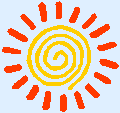Shoemaker-Levy 9
Worksheet
What would happen if a comet or asteroid hit a planet in our Solar
System? In July of 1994, scientists and amateur astronomers alike were
fortunate enough to witness the bombardment of Jupiter by the comet
Shoemaker-Levy 9. Having been broken apart two years earlier on an
approach to the giant planet, the comet actually consisted of 21
fragments, each of which made a separate impact. Most of the fragments
were between 1 and 2 km in diameter and so were actually very similar
in impact energy to the New York-bound asteroid simulated in the
previous activity. Other fragments were much larger and left scars on
Jupiterís surface two to three times the size of Earth.
1. Go to http://Ö and click on the image to see a
computer-generated animation of several of the comet fragments
striking the surface of Jupiter.
Telescopes around the world were able to capture images of the
stricken planet as it rotated into view just hours after the
collisions occurred. The unmanned spacecraft Galileo, on its way to
orbit Jupiter in 1994, was positioned to actually capture the live
collisions unobservable from Earth. Cameras on the Hubble Space
Telescope captured other important images.
2. Return to the activity site (http://Ö) and click on the links
to the impact images.
3. How do you suppose the impacts affected Jupiter? Did they
produce the same catastrophic events seen on Earth after the K/T
impact? Use library resources and the Internet to research the
planet Jupiter. What is it made of? How big is it compared to
Earth? What is its atmosphere like? Record your findings below.
_________________________________________________________
_________________________________________________________
_________________________________________________________
_________________________________________________________
4. Based on your research of Jupiter, what can you say about how
the effects of an impact on Jupiter would differ from the effects
of an impact on Earth?
_________________________________________________________
_________________________________________________________
_________________________________________________________
_________________________________________________________
5. What do you think scientists were able to learn by studying how
the dark spots seen in the images changed over the months
following the impacts?
_________________________________________________________
_________________________________________________________
_________________________________________________________
Activity
In July of 1994, a series of 21 comet fragments broken off from an
original solid comet struck the surface of Jupiter. The comet, named
after the amateur scientists who discovered it, was known as
Shoemaker-Levy 9.
1. Click on the animation below to see a simulation of five of the
21 fragments striking Jupiter.
<animation>
2. Return to your worksheet.
3. Click on the links below to see actual pictures of the planet
Jupiter after one or more fragment impacts.
<image links, or images>
Image 1: Back in 1992, the comet had made a very close approach
to Jupiter. As the comet came near Jupiter, unequal gravitational
forces broke the comet into 21 fragments which then traveled in
Jupiterís orbit for two more years before colliding with the
planet in 1994. More than a million kilometers separated the first
icy fragment in the chain from the last.
Image 2: This image was assembled from several different pictures
captured aboard the Hubble Space Telescope. Taken just two months
before impact, the image clearly shows the fragments lining up to
bombard Jupiterís surface.
Image 3: Multiple fragment impacts left what is known as the
"chain of pearls" on Jupiterís surface, so called
because they wrapped around the planet like a necklace. These images
were taken July 25th, 1994, several days after the last
major fragment hit Jupiter.
Images 4-6: Large quantities of dust spewed up into the
stratosphere by the impacts absorb sunlight and so create dark spots
on the images.
Image 5: Fragment A struck Jupiter at an angle of 45o
from the vertical. Lower-angle impacts kick up more debris than
higher-angle impacts.
4. Return to your worksheet.

